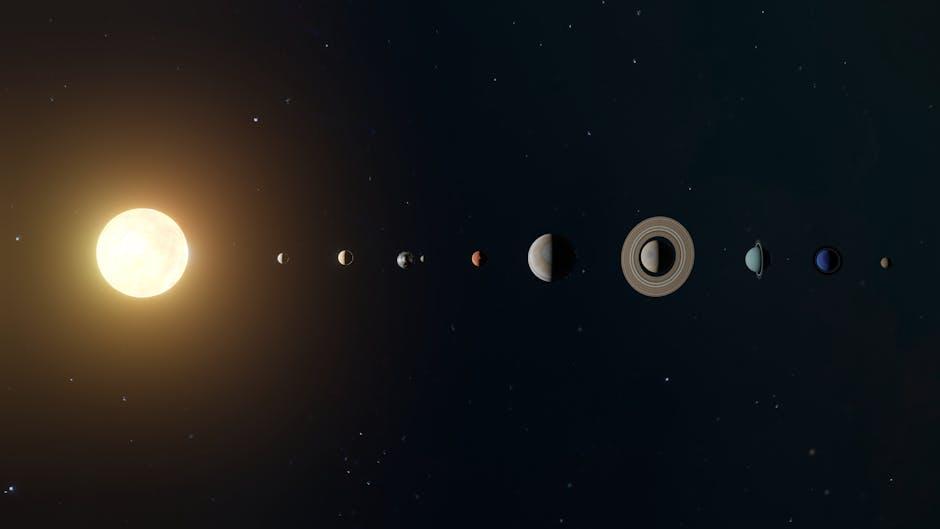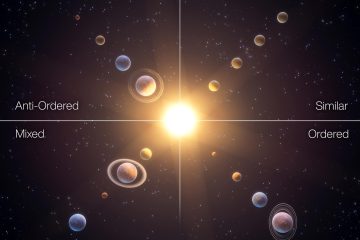Table of Contents
- Diverse Worlds A Journey Through Planetary Types
- Discovering the Mysteries of Gas Giants and Ice Giants
- Rocky Surfaces and Volcanic Activity Understanding Terrestrial Planets
- Unveiling Exoplanet Diversity Insights Beyond Our Solar System
- Exploring Habitable Zones Identifying Planets Fit for Life
- Q&A
- To Wrap It Up
Diverse Worlds A Journey Through Planetary Types
Exploring the cosmos unveils a stunning array of celestial wonders, each capturing the imagination with its distinct characteristics. Rocky planets, also known as terrestrial planets, form the inner sanctum of many solar systems. These planets, primarily composed of silicate rocks or metals, include Earth and its neighbors, Mercury, Venus, and Mars. They feature solid surfaces that may exhibit majestic mountains, endless deserts, and tempestuous volcanoes. The unique atmospheres of these planets, ranging from Venus’ thick, acidic clouds to Mars’ thin, dusty blanket, highlight the diversity of conditions that exist in our universe.
Venturing further, we encounter gas giants, colossal planets with no definite surface, their boundless atmospheres composed primarily of hydrogen and helium. Jupiter and Saturn are prime examples, showcasing awe-inspiring bands and massive storm systems. The famed Great Red Spot on Jupiter, a storm three times the size of Earth, stands as a testament to the unimaginable forces at play. The intricacies of Saturn’s rings—composed of ice particles, rocky debris, and dust—intrigue astronomers and laypeople alike, capturing the dynamic spectacular of gravitational interactions on a cosmic scale.
Beyond the gas giants, ice giants like Neptune and Uranus introduce a new realm of complexity. While sharing atmospheric similarities with their larger cousins, these planets contain heavier elements, such as water, ammonia, and methane, forming their deep slushy interiors. This composition grants them distinctive colors; for instance, Neptune’s deep azure is due to methane absorption of red light. Key Attributes of Ice Giants include:
- Unique Atmospheric Compositions – Higher concentrations of volatile compounds.
- Extreme Weather Patterns – Violent winds reaching up to 1,200 mph.
- Magnetic Field Anomalies – Tilted axes significantly offset from their planes.
| Planet Type | Core Composition | Signature Feature |
|---|---|---|
| Terrestrial | Metallic/Rocky | Solid Surface |
| Gas Giant | Gaseous | Amazing Storm Systems |
| Ice Giant | Ice/Compound-rich | Vivid Colors |

Discovering the Mysteries of Gas Giants and Ice Giants
Amid the vast expanse of our solar system, the colossal gas giants—Jupiter and Saturn—stand as magnificent titans. Composed primarily of hydrogen and helium, these massive planets challenge our understanding of planetary formation and atmospheric dynamics. Jupiter, the grandest of all, mesmerizes with its swirling clouds and enduring storms like the famous Great Red Spot. Saturn’s awe-inspiring rings, made of ice and rock particles, continue to intrigue scientists as they unravel their origins and evolution. These gas giants not only captivate with their majestic appearances but also serve as laboratories for testing theories of planetary science.
The enigmatic ice giants, Uranus and Neptune, beckon with their distant, icy allure. Unlike their gaseous counterparts, these giants harbor more compounds such as water, ammonia, and methane ice, giving rise to their striking blue hues. Uranus, with an unusual axial tilt, spins on its side, presenting a unique case of planetary dynamics and seasonal changes. Meanwhile, Neptune showcases dynamic weather patterns and the fastest winds recorded in the solar system, challenging astronomers to uncover the mysteries of its deep atmosphere. These ice giants are crucial for understanding the diversity and complexity of planetary systems.
| Planet | Type | Main Components | Notable Features |
|---|---|---|---|
| Jupiter | Gas Giant | Hydrogen, Helium | Great Red Spot |
| Saturn | Gas Giant | Hydrogen, Helium | Ring System |
| Uranus | Ice Giant | Water, Ammonia, Methane | Axial Tilt |
| Neptune | Ice Giant | Water, Ammonia, Methane | Fastest Winds |

Rocky Surfaces and Volcanic Activity Understanding Terrestrial Planets
Terrestrial planets, often recognized by their solid, rocky surfaces, present a fascinating landscape shaped by myriad geological processes. These celestial bodies are characterized by a dense composition of silicate minerals and metals, creating terrains that range from jagged mountain ranges to expansive flatlands. Understanding these surfaces offers critical insight into the history and evolution of each planet, providing clues about their geologic past and potential for sustaining life. The surface features such as impact craters, tectonic plates, and valley networks each tell a story of volcanic eruptions, meteorite impacts, and surface weathering.
- Impact Craters: Formed by meteor collisions, revealing age and activity.
- Tectonic Features: Indicate plate movement and historical volcanic activity.
- Volcanic Landscapes: Result from eruptions and lava flows, reshaping terrains.
Volcanic activity plays a pivotal role in the transformation and development of terrestrial planets. Volcanism not only introduces new materials to the surface but also possibly contributes to the creation of an atmosphere over time. For example, Mars showcases vast lava plains, while Venus is known for its extensive volcanic peaks and flows. This volcanic landscape is a testament to the dynamic processes below the crust, where intense heat and pressure mold the planet’s surface. Monitoring such activities helps scientists predict possible changes and the evolution of these planetary bodies over extended periods.
| Planet | Key Volcanic Features |
|---|---|
| Earth | Complex plates and diverse volcanic activity |
| Mars | Olympus Mons, lava plains |
| Venus | Maxwell Montes and shield volcanoes |
| Mercury | Basalt plains |
Analyzing the rocky and volcanic characteristics of these planets allows scientists to draw parallels and contrasts with Earth, enhancing our understanding of planetary systems. These studies also aid in the search for extraterrestrial life by identifying possible hospitable environments that may have once existed or could still endure within these fascinating terrestrial worlds. Exploring these vibrant geological landscapes opens doors to further innovations in space exploration and a deeper realization of our own planet’s mysteries.

Unveiling Exoplanet Diversity Insights Beyond Our Solar System
The journey to understanding planets beyond our own solar system reveals a tapestry of diverse worlds, far more varied than the planets orbiting our familiar Sun. Unlike our neat planetary system, exoplanets present a colorful assortment of characteristics, captivating scientists with unexpected uniqueness. Imagine gas giants hugging their stars so closely that their atmospheres are subjected to extreme temperatures, creating spectacular storms of molten iron rain. These celestial wonders, often referred to as Hot Jupiters, defy conventional planetary categorizations and compel astronomers to rethink planetary formation theories.
In stark contrast, there are rocky worlds that challenge our terrestrial assumptions. Some exoplanets are identified as Super-Earths—planets with masses larger than Earth but lower than Neptune. These intriguing worlds broaden our understanding of possibilities for planetary formation and habitability. While Earth hosts life as we know it, Super-Earths tantalize with potential, each orbit a unique environment holding mysteries yet to be unraveled. Their atmospheres can range from scorching to idealistic, enveloping surfaces that remain mysterious yet highly intriguing to astrobiologists searching for signs of life.
Astounding types of exoplanets even include Water Worlds, where vast oceans cover the planets’ entire surfaces, creating global aquatic environments. Here’s a glimpse at the incredible diversity of these exoplanet types:
- Super-Jupiters: Gain their name from immense sizes, even more massive than Jupiter itself, often exhibiting intense stormy weather.
- Mini-Neptunes: Smaller than Neptune, these planets may possess thick gaseous envelopes or potentially substantial water content.
- Lava Worlds: Formed so near their stars that their surfaces are seas of molten lava, hinting at their departed rocky cores.
Below is a succinct table showcasing a few notable exoplanet discoveries:
| Exoplanet Name | Type | Key Feature |
|---|---|---|
| Kepler-186f | Super-Earth | Potential for liquid water |
| 51 Pegasi b | Hot Jupiter | Close stellar orbit, blazing temperatures |
| Gliese 1214 b | Water World | Thick atmosphere, possible hot ocean |
These diverse planetary portraits not only deepen our comprehension of the cosmos but also ignite our curiosity about what other celestial phenomena might await discovery in the uncharted regions of our universe.

Exploring Habitable Zones Identifying Planets Fit for Life
In the quest to understand which planets might harbor life, scientists focus on the so-called “Goldilocks zone” where conditions are neither too hot nor too cold for liquid water, a crucial ingredient for life as we know it. Planets located within these zones—often referred to as habitable zones—present the most promising opportunities for discovering life beyond Earth. The size and atmosphere of these celestial bodies play a critical role in determining their potential to support living organisms.
Many factors influence a planet’s habitability, including its atmospheric composition and distance from its host star. The following are key characteristics scientists look for in potentially habitable planets:
- Atmosphere: A thick, protective atmosphere can regulate temperature and provide essential gases.
- Water Presence: Signs of surface or subsurface water are vital for life.
- Orbital Stability: Consistent stellar energy without extreme fluctuations supports sustained environmental conditions.
| Planet Type | Description |
|---|---|
| Terrestrial | Rocky surfaces similar to Earth, often within the habitable zone. |
| Super Earth | Similar in composition to terrestrial but larger in size. May possess thick atmospheres. |
| Mini-Neptune | Gaseous with deep atmospheres, sometimes possessing rocky cores. |



0 Comments